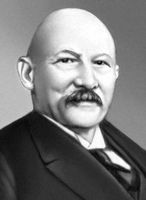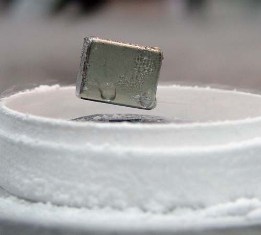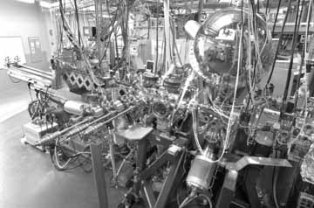The discovery of superconductivity
Helium was first inhaled in 1908 by Heike Kamerling-Onnes at Leiden University, and since then it has become possible to study physical phenomena at temperatures only a few degrees above absolute zero (the boiling point of helium at atmospheric pressure is 4.2 K).
 One of the areas of research concerned the dependence of the resistance of metals on temperature. Kamerling-Onnes has already carried out similar studies at temperatures decreasing up to the temperature of liquid air (about 80 K).
One of the areas of research concerned the dependence of the resistance of metals on temperature. Kamerling-Onnes has already carried out similar studies at temperatures decreasing up to the temperature of liquid air (about 80 K).
For several pure metals, he found an approximately linear relationship, but he found that such a relationship can not continue unlimitedly, since otherwise, at absolute zero, the resistance would become negative. Sir James Dewar continued the research of Kamerlingh Onnes and reached the temperature of liquid hydrogen (20 K), while it became clear that the resistance really begins to decrease more slowly.
This was to be expected, not only for the reason already mentioned, but also on the basis of the ideas about metals and their properties that were accepted at that time.
It was believed that the electrical conductivity is carried out by electron transfer, and the resistance arises from collisions of electrons with metal atoms.
The linear nature of the decrease in resistance was completely consistent with the assumed change in the motion of the electrons with decreasing temperature. It was expected, however, that at sufficiently low temperatures, the electrons "condense" on atoms, then the resistance at a certain temperature should be minimal, and then the metal must go into a dielectric.
The behavior of metals observed in reality differed sharply from the expected. Kamerling-Onnes found that when the temperature is lowered, the resistance of most metals tends to a constant value, while for some metals it completely disappears at a certain, characteristic temperature, which, as it turned out, depends on the strength of the magnetic field. These experiments are among the works for which Kamerling-Onnes was awarded in 1913 the Nobel Prize in Physics.
For more than two decades, it was the disappearance of resistance that was considered the main, distinctive feature of superconductivity. However, some features of this phenomenon led scientists to be confused.

So, if a magnetic field is applied to a conventional conductor (not just a ferromagnet), part of the magnetic flux passes through the thickness of the conductor. If applied to an ideal conductor, the surface currents are induced in the latter, which create a magnetic field inside the conductor that completely compensates for the applied external field, and thus maintains a zero value of the magnetic flux inside the conductor.
This meant that the state of the conductor in a magnetic field depends on how this state was achieved - the situation is extremely unpleasant.
Later, in 1933, V. Meisner, R. Oksenfeld and F. Heidenreich showed that the metal, becoming a superconductor, actually pushes out the magnetic flux if the temperature falls below the critical value when the sample is in a magnetic field.
The next stage of the study was to study the newly discovered state at high current values. The need for such a study was dictated by the following circumstance: if the resistance were not actually zero, then a larger current would lead to a larger, and therefore easier, the recorded value of the potential difference.
However, the results obtained only further confused the situation, since "a special phenomenon was observed: at any temperature below 4.18 K, for a mercurial filament enclosed in a glass capillary, there was a certain threshold value of the current density, above which the nature of the phenomenon changed drastically. At current densities below threshold, the electric current passes without any noticeable potential differences applied to the ends of the filament. This indicated that the thread does not have resistance.
As soon as the current density exceeded the threshold value, a potential difference appeared, which also grew faster than the current itself. " Then a series of experiments was performed to find an explanation for the new effect. First of all, it was noted that the threshold current density increased with decreasing temperature-roughly proportional to the deviation from the temperature of the transition to the superconducting state (until the difference between the temperatures was not too high). Naturally, the assumption arose that due to the heating caused by some effect, the mercury temperature rose above the transition point. The task was to find this source of heat.
Using various configurations of the mercury thread, it was possible to establish that the heat was not supplied from the outside. The influence of impurities in mercury was considered, although during the distillation they had to be removed; Experiments have shown that the heating effect is not associated with impurities specially added in the right quantities.
Further, it was suggested that, possibly, the contact of a mercury thread with a conventional conductor, somehow found in it or formed within it, can annihilate the superconducting properties of mercury. For verification, a steel capillary was taken, but this did not lead to any definite results, and only later, as a result of experiments of the same type on tin, this assumption was ruled out. In general, experiments with mercury did not answer the question posed.
However, as established by Camerling-Onnes, mercury was not entirely suitable for systematic research. "The joint action of many circumstances led to difficulties when working with mercury in capillaries.

The day of the experiment with liquid helium required enormous preparation, and when it came directly to the experiments described here, only a few hours remained. In order to conduct accurate measurements with liquid helium under these conditions, it is necessary to plan the program in advance and perform it quickly and methodically on the day of the experiment. Changes in the formulation of the experiment, the necessity of which was caused by the observed phenomena, usually had to be made the next day.
Often, due to some delay caused by the laboriousness of the process of making resistances, the helium installation was used for some other purpose. When we could again do the experiment, it happened that the prepared resistance proved to be useless, since during the freezing of mercury the thread was torn, and all our efforts became vain. In these circumstances, in order to detect and exclude sources of unexpected and misleading interference, it took a very long time.
In addition, it was desirable to cool the sample not through the capillary wall, but by its direct contact with liquid helium. Therefore, when Kamerling-Onnes discovered that tin and lead possess properties similar to those of mercury, he continued experiments with these two metals. It was then that the problem was posed and solved.
Essentially, the hope for its solution arose already in the experiments in which superconductivity of lead was discovered. From it, it was easy to make a wire, and a fairly large amount of wire with a cross section of 70 mm2 was made. For a single conductor of this size, the current threshold at 4.25 K was 8 A. Then, a 1-cm-long coil containing 1000 turns was wound on this core with a diameter of 1 cm. The winding had silk insulation, which is wetted with liquid helium. As it turned out, the threshold value of the current was only 0.8 A.
In 1913, interest in obtaining strong magnetic fields was already large enough, and there was no doubt that the main problem was related to power dissipation in the winding. For example, Perrin suggested using liquid air for cooling; It was expected that due to the decrease in winding resistance with decreasing temperature, the amount of heat released in it will decrease, which will give a certain gain.
Calculations showed, however, that there is no gain in this way, first of all, this is due to the fact that it is very difficult to achieve the required heat transfer between the supposedly compact coil and the cooler. Kamelelyig-Ones correctly estimated the possibility of using superconductors for this purpose, drawing attention to the fact that in them heat should not be released at all. Speaking of this, however, he admitted "the possibility that a magnetic field can lead to the appearance of resistance in a superconductor." And he began to study this question.
"There were reasons to believe that this effect will be weak. Direct evidence that only insignificant resistance appears in the superconductors due to the magnetic field was obtained when it turned out that the coil described above remains superconducting even if it passes through the current of 0.8 A. The field of the coil itself in this case reached several hundred gauss , And in a field of this order of magnitude there was a large part of the turns, but no resistance was observed. " Therefore, Camerling-Onnes created such a setup for carrying out these experiments, which would allow studying phenomena observed only in fields of the order of kilogaus.
The results were again unexpected. The superconducting lead coil used in the previous experiments was placed in a cryostat so that the plane of the turns was parallel to the magnetic field.
"First of all, we were convinced in Volume that the coil would be superconducting at the boiling point of helium; It remained superconducting even when a current of 0.4 A was passed through it, although the turns were in a noticeable magnetic field created by the current flowing in them.
Then a magnetic field was applied. With a field strength of 10 kG, there was considerable resistance, at 5 kG, it was somewhat less. These experiments have convincingly demonstrated that a magnetic field at high intensities causes the appearance of resistance in superconductors, and for a small one, no. In the course of further research, the dependence of the resistance on the field was obtained.
Kamerling-Onnes was not yet ready to connect the critical current with the critical value of the magnetic field. He had no doubt that the phenomenon discovered here was due to the sudden occurrence at a certain temperature of the usual resistance in superconductors-this connection was found out by other researchers. Nevertheless, it could be considered that the foundation was laid.
Over time, however, the paradox described at the beginning of this chapter has become very obvious. A small change in the wording further strengthened it. If the substance, being in a magnetic field, should have passed into an ideally conducting state with decreasing temperature, then the magnetic flux penetrating the sample at the time of transition should remain "frozen" in it and be preserved at the subsequent switching-off of the field (if the temperature is maintained at the same time) .
Having prepared various samples in this way, it would be possible to create a set (in principle infinite) of different states existing under the same external conditions, which, perhaps, could even be in thermal contact with each other, ie, in a state of equilibrium.
Until 1933, such a possibility was not disproved experimentally, and some experiments seemed to even confirm it. There were even theoretical considerations in its favor. And at that moment Meissner, studying the transition to the superconducting state, was struck by the appearance of a kind of hysteresis: the return of the tin single crystal to the normal state occurred at a temperature slightly higher than the superconducting transition temperature.
This effect was observed even when the resistance at each point was measured in two directions of the current by a method specially developed to eliminate thermoelectric phenomena, if the direction of the current did not change, the effect intensified. Hysteresis suggested that the phenomenon is associated with a change in the permeability of the sample.
Meisner wrote about this as follows: "If the distribution of the measured current and the magnetic field created by it did not change, there would be no basis for the appearance of hysteresis phenomena." Therefore, he and his staff assume that his permeability drops to zero. If this were the case at all, then no force line of the field could end on the inner surface of the cavity of the superconductor, whereas experiments clearly show that the situation is exactly this.
Many years passed before it was possible to create a satisfactory theory of superconductivity; In fact, this issue was not finally solved even in 1972. However, Meissner's discovery at least allowed us to give a satisfactory macroscopic treatment of the observed phenomena.
G. Trigg "Physics of the twentieth century: Key experiments"


Comments
Commenting on, remember that the content and tone of your message can hurt the feelings of real people, show respect and tolerance to your interlocutors even if you do not share their opinion, your behavior in the conditions of freedom of expression and anonymity provided by the Internet, changes Not only virtual, but also the real world. All comments are hidden from the index, spam is controlled.